Sarah L. Johnson's Blog, page 111
November 18, 2013
Shona Patel's Teatime for the Firefly, a transporting novel of 1940s India
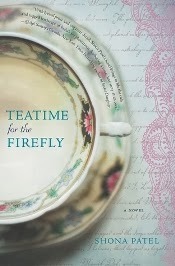 Looking at an unopened copy of Teatime for the Firefly, you may take it to be a delicate work of women's literature, something involving tea-drinking and love letters, perhaps with an international flair. This is only partly accurate; while the cover reflects some of its subjects, it just barely hints at the vibrancy to be found inside.
Looking at an unopened copy of Teatime for the Firefly, you may take it to be a delicate work of women's literature, something involving tea-drinking and love letters, perhaps with an international flair. This is only partly accurate; while the cover reflects some of its subjects, it just barely hints at the vibrancy to be found inside.Immersive and deeply romantic, Shona Patel's debut novel is a passport into the rich culture of Assam in northeast India, beginning in 1943 and continuing through the Hindu-Muslim conflicts.
Our guide is Layla Roy, who begins by telling us she was born under an unlucky star. "Marriages in our society are arranged by astrology and nobody wants a warlike bride," she explains. Thankfully, though, this is no cautionary tale about the dangers of avoiding one's fate. Layla is raised by her enlightened grandfather, Dadamoshai, who believes in women's education and gives her the liberty to pursue her future – which, to her surprise, includes Manik Deb, a handsome British-educated civil servant who is already engaged to another woman. Just like Layla, Manik has a talent for directing his own destiny.
With a voice filled with honesty, warmth, and gentle humor, Layla speaks about her secret correspondence with Manik, her amazement at the marriage she never expected to have, and her adjustments to life as the only Indian memsahib on an immense tea plantation in the remote jungles of Assam. Patel seamlessly incorporates many details on the geography and traditions of her homeland to enrich the story, from the politics of leopard hunts to the garish makeup Layla's Spinster Aunt makes her wear at her wedding – this was hilarious! – to the tea crowd's denigrating treatment of a Scottish planter's Bangladeshi concubine. The choices Layla makes for herself aren't without risk, but such is the nature of freedom, and of life.
The novel kept my attention from the first engaging sentence through the finale, which had me holding my breath during the more frightening moments. And although I've never personally set foot in Assam or anywhere in India, it's a testament to Patel's generous storytelling that I felt completely welcomed into Layla's world.
Teatime for the Firefly was published by Harlequin/MIRA in October at $15.95 US/$18.95 Can (trade pb, 422pp). I picked up an ARC at the publisher's booth at ALA this summer.
Published on November 18, 2013 17:00
November 15, 2013
Thanksgiving by Ellen Cooney, a bountiful feast of historical holiday sketches
Ellen Cooney's new e-book release centers on the members of a single family (the Morleys), how they relate to one another and the world around them, and the changing modes of daily life in Dedham, Massachusetts, over a period of 350 years. Its slices-of-history structure is Micheneresque in a way, although Thanksgiving is more domestically oriented and saga-like.
Named after a holiday, and with chapter titles reflecting different years and the ingredients that make up a traditional New England Thanksgiving – "1801: Cranberries," for example – it could have come off feeling formulaic and gimmicky. It isn't at all.
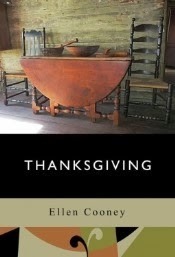 Each chapter focuses on a female Morley and brings readers into her thoughts at a particular moment in late November as she helps prepare part of the Thanksgiving meal at the family home. In the second segment, set in 1673, young Hester Morley would much rather be spending time drawing or watching her father whittling than picking seeds out from pumpkins before they're dried, cooked, or sold. Over three centuries later, in 2012, another young Hester, visiting from Boston with her techie parents, thinks about her favorite movies, her iPod, and her diverse group of relatives while looking out at the kitchen window at her ancestors' graves.
Each chapter focuses on a female Morley and brings readers into her thoughts at a particular moment in late November as she helps prepare part of the Thanksgiving meal at the family home. In the second segment, set in 1673, young Hester Morley would much rather be spending time drawing or watching her father whittling than picking seeds out from pumpkins before they're dried, cooked, or sold. Over three centuries later, in 2012, another young Hester, visiting from Boston with her techie parents, thinks about her favorite movies, her iPod, and her diverse group of relatives while looking out at the kitchen window at her ancestors' graves.
In between, many other Morley women grow up, fall in love, marry, and mature into the matriarchal role that awaits them. The novel is full of memorable moments, and some funny ones, too. For example, Lydia Morley hates that her husband has bought a box of new dinner plates from Worcester, England, at the height of revolutionary fervor in 1778. Her curious and hungry children, being children, don't care.
Nothing has ever displaced supper before.
"Horrible battles were happening while that thing," says Lydia, pointing to the box, "was sitting in Boston. Do you understand where it came from? It came from the same people who killed Americans."
"Bunker Hill!" cries little Ira, clapping his plump hands together. He's thrilled about standing on a chair in this extraordinary situation. Then he nearly topples over when he screams at the top of his lungs, "CAN WE LOOK IN THE BOX NOW CAN WE CAN WE CAN WE?"
The viewpoint characters in one chapter may become secondary characters in the next, and after they're gone they turn into memories which their descendants recall fondly. This creates an image of the Morleys over time as a solidly woven, unbroken braid. Cooney ensures that the Morley name continues over the ages even though some lines of descent pass through daughters rather than sons, and she presents these scenarios in ways that reflect the social concerns of each era.
Sparely told and replete with sensitive descriptions of relationships, including grandmotherly affection and the occasional awkwardness between mothers and daughters-in-law, the novel shows how family stories like the shooting of the original Morley turkey and the discovery of one woman's lost spectacles transform over decades, and centuries. Each woman has only a short amount of time on the page (or e-reader screen, in this case), which may leave readers wanting more, but the character sketches are deft, with illustrative details packed into every sentence.
If you enjoy literary historical fiction, consider adding Thanksgiving to your e-bookstore shopping basket and curling up with it as the end-of-year holidays approach. A caution against reading it when you're hungry, or you may find yourself heading to the store in search of pumpkin pie and warm, yeasty bread.
It can just as easily be read at other times of year, though, as its themes and images are universal. "Tell me a story, he'd say, as if the past weren't the past, but something to enter the little space around them, as real as an object he could hold in his hands," reminisces Eliza Morley in 1726 about her son Caleb, now an adolescent who's grown apart from her... or so she thinks. In Thanksgiving, these personal stories derived from history become as tangible as fresh as those of today.
Ellen Cooney's Thanksgiving was published in September by Publerati as an ebook in various formats ($4.99; see options at Publerati's website). Thanks to the publisher for granting me access via NetGalley.
Named after a holiday, and with chapter titles reflecting different years and the ingredients that make up a traditional New England Thanksgiving – "1801: Cranberries," for example – it could have come off feeling formulaic and gimmicky. It isn't at all.
 Each chapter focuses on a female Morley and brings readers into her thoughts at a particular moment in late November as she helps prepare part of the Thanksgiving meal at the family home. In the second segment, set in 1673, young Hester Morley would much rather be spending time drawing or watching her father whittling than picking seeds out from pumpkins before they're dried, cooked, or sold. Over three centuries later, in 2012, another young Hester, visiting from Boston with her techie parents, thinks about her favorite movies, her iPod, and her diverse group of relatives while looking out at the kitchen window at her ancestors' graves.
Each chapter focuses on a female Morley and brings readers into her thoughts at a particular moment in late November as she helps prepare part of the Thanksgiving meal at the family home. In the second segment, set in 1673, young Hester Morley would much rather be spending time drawing or watching her father whittling than picking seeds out from pumpkins before they're dried, cooked, or sold. Over three centuries later, in 2012, another young Hester, visiting from Boston with her techie parents, thinks about her favorite movies, her iPod, and her diverse group of relatives while looking out at the kitchen window at her ancestors' graves.In between, many other Morley women grow up, fall in love, marry, and mature into the matriarchal role that awaits them. The novel is full of memorable moments, and some funny ones, too. For example, Lydia Morley hates that her husband has bought a box of new dinner plates from Worcester, England, at the height of revolutionary fervor in 1778. Her curious and hungry children, being children, don't care.
Nothing has ever displaced supper before.
"Horrible battles were happening while that thing," says Lydia, pointing to the box, "was sitting in Boston. Do you understand where it came from? It came from the same people who killed Americans."
"Bunker Hill!" cries little Ira, clapping his plump hands together. He's thrilled about standing on a chair in this extraordinary situation. Then he nearly topples over when he screams at the top of his lungs, "CAN WE LOOK IN THE BOX NOW CAN WE CAN WE CAN WE?"
The viewpoint characters in one chapter may become secondary characters in the next, and after they're gone they turn into memories which their descendants recall fondly. This creates an image of the Morleys over time as a solidly woven, unbroken braid. Cooney ensures that the Morley name continues over the ages even though some lines of descent pass through daughters rather than sons, and she presents these scenarios in ways that reflect the social concerns of each era.
Sparely told and replete with sensitive descriptions of relationships, including grandmotherly affection and the occasional awkwardness between mothers and daughters-in-law, the novel shows how family stories like the shooting of the original Morley turkey and the discovery of one woman's lost spectacles transform over decades, and centuries. Each woman has only a short amount of time on the page (or e-reader screen, in this case), which may leave readers wanting more, but the character sketches are deft, with illustrative details packed into every sentence.
If you enjoy literary historical fiction, consider adding Thanksgiving to your e-bookstore shopping basket and curling up with it as the end-of-year holidays approach. A caution against reading it when you're hungry, or you may find yourself heading to the store in search of pumpkin pie and warm, yeasty bread.
It can just as easily be read at other times of year, though, as its themes and images are universal. "Tell me a story, he'd say, as if the past weren't the past, but something to enter the little space around them, as real as an object he could hold in his hands," reminisces Eliza Morley in 1726 about her son Caleb, now an adolescent who's grown apart from her... or so she thinks. In Thanksgiving, these personal stories derived from history become as tangible as fresh as those of today.
Ellen Cooney's Thanksgiving was published in September by Publerati as an ebook in various formats ($4.99; see options at Publerati's website). Thanks to the publisher for granting me access via NetGalley.
Published on November 15, 2013 11:00
November 14, 2013
Scenes from the life of a wannabe artist, 1812: a guest post by Nathaniel Popkin
Today's guest essay is from Nathaniel Popkin, author of Lion & Leopard, who discusses one of his main characters, the duplicitous would-be painter Pavel Svinin, as well as the combination of creativity and truth involved in transforming historical personages into fiction.
~
Scenes from the life of a wannabe artist, 1812Nathaniel Popkin
At the age of twenty-three in 1811, Pavel Petrovitch Svinin, a distant relative of the poet Lermontov, arrived in Philadelphia a minor official in the Russian consulate. Svinin, who imagined himself a painter from the Russian Academy, could speak English, which made him one of the few people suitable for the job. Almost immediately, he offered to a Philadelphia publisher some essays and pictures he claimed were his own, “taken from nature,” for a book on Moscow and St. Petersburg. The pictures were poorly executed copies, “exceedingly uneven stylistically,” as art historian Anneliese Harding, with herculean restraint, points out. In spring 1812, he exhibited a few of them at the annual show of the Pennsylvania Academy of Fine Arts.
In that same show, the painter Rembrandt Peale presented his much anticipated painting The Roman Daughter, based on an ancient story of a girl who allows her imprisoned father to suckle from her breast to save him from starvation. Rembrandt was the second son of the American art progenitor Charles Willson Peale, who made a habit of naming his children for European masters with the idea that his American copies would live up to their names (Rembrandt certainly believed the hype). Standing in the gallery, the flippant Svinin, already with a reputation as a braggart and windbag, offhandedly claimed that Rembrandt’s painting was no more than a plagiarism of a painting by Gérard, humiliating him in broad view. When forced to justify his statement, Svinin retreated.
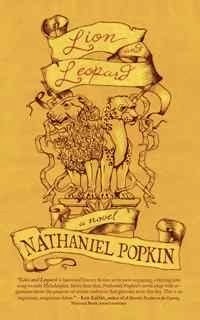 Later that year, Svinin purchased fourteen watercolor sketches from another artist on the Philadelphia scene, the German immigrant John Lewis Krimmel. Svinin intended to use the pictures in a book he would go on to publish in Russia in 1815 called A Picturesque Voyage in North America. In the book, Svinin presents Krimmel’s pictures as his own (now in the collection of the Metropolitan Museum of Art, these pictures, despite ample proof otherwise, remain assigned to Svinin). Moreover, in the same book, Svinin, who had left the U.S. to join French pro-royalists in battle against Napoleon, is withering in his attack on a Rembrandt painting of Napoleon on horseback, painted “as though to demonstrate that he had neither art, nor taste nor knowledge!” He continues, “There is nothing in this picture that is above censure. Yet the author of it is so vainglorious that he considers it a model of the art.” A sentence later, however, our insouciant Svinin reverses course on The Roman Daughter, calling it “a very good picture.”
Later that year, Svinin purchased fourteen watercolor sketches from another artist on the Philadelphia scene, the German immigrant John Lewis Krimmel. Svinin intended to use the pictures in a book he would go on to publish in Russia in 1815 called A Picturesque Voyage in North America. In the book, Svinin presents Krimmel’s pictures as his own (now in the collection of the Metropolitan Museum of Art, these pictures, despite ample proof otherwise, remain assigned to Svinin). Moreover, in the same book, Svinin, who had left the U.S. to join French pro-royalists in battle against Napoleon, is withering in his attack on a Rembrandt painting of Napoleon on horseback, painted “as though to demonstrate that he had neither art, nor taste nor knowledge!” He continues, “There is nothing in this picture that is above censure. Yet the author of it is so vainglorious that he considers it a model of the art.” A sentence later, however, our insouciant Svinin reverses course on The Roman Daughter, calling it “a very good picture.”
All this takes place in my book Lion and Leopard, a work of literary historical fiction released this week by The Head & The Hand Press. My fictional Svinin, Rembrandt, and Krimmel are semblances, assuredly, of the historical figures as gleaned from the available record, perhaps as Rembrandt himself was a semblance of a lauded master.
But my interest in Svinin continues beyond his time in Philadelphia to his misadventures later on in Russia (indeed, I grant him a return to the U.S.). This period, as it turns out, was, fictionalized by the writer Nicolai Gogol in the 1835 drama The Government Inspector. It’s this fictional portrayal that came to color the Svinin of Lion and Leopard.
The year he published his rather fraudulent A Picturesque Voyage in North America, Svinin, still a minor bureaucrat, was sent to Bessarabia to observe village life (one wonders if it wasn’t an excuse to get the annoying man out of the capital). Thinking he was sent there on a military or political mission of some importance, the villagers plied Svinin with gifts and treated him to banquets, which he was more than happy to accept, as proof to himself of his outsized importance. Svinin played the naïve villagers for money and treats as he promised them advantages he could never deliver.
In 1821, having heard of Svinin’s misadventures, Pushkin sought him out for an explanation. Now Svinin claimed his own naïveté. Pushkin passed the story along to Gogol, who turned Svinin into Khlestakov, the title character of his first overtly serious work, The Government Inspector. Meaning “to lash” or “to prattle” or “to lie,” “Khlestakov’s very name is a stroke of genius,” says Nabokov, “for it conveys to the Russian reader an effect of lightness and rashness, a prattling tongue, the swish of a slim walking cane, the slapping sound of playing cards, the braggadocio of a nincompoop and the dashing ways of a lady-killer.” From scene eight of The Government Inspector (Penguin Classics edition, in translation from the Russian by Ronald Wilks):
The Svinin of Lion and Leopard, a book whose central themes are originality and duplicity, naturally had to quote from Gogol’s Khlestakov. There’s a certain historical justification for this: Gogol’s 1835 version of Svinin is close to contemporary (Svinin died in 1839). But a work of literary historical fiction has three masters: history, fiction, and literature. As a version of history, it has to acknowledge a distant past that may not, as the Norwegian writer Karl O. Knausgaard has posited, be readily understandable. So it has to recreate that world and also pay heed to the distance between, say 1813, when Svinin left Philadelphia, and 2013. (In A Time for Everything, Knausgaard does so by having his biblical-era characters wear sneakers.) As fiction, of course, it has to conform to the narrative rules of conflict, reversal, and denouement.
As literature—or art, really—which grants the work certain cover from the necessarily specific pursuit of history, it must engage in the ancient conversation about letters—about man’s relationship to each other and the earth. One enters that conversation by quoting, riffing, devouring, plunging into the vast impossible library that came before and that will go on forever. This is an ancient practice. “An artist would adapt a pose or even an entire composition to his own story requirements, sometimes in the expectation that the theme of the earlier painting would help to explain the current meaning,” says Rembrandt Peale biographer Lillian Miller, in explaining the context of Svinin’s outburst at the Pennsylvania Academy show. Notably, Miller goes on to say that this act of quoting is the seed of creativity. Svinin, she says, “was attacking the very heart of the artistic process—the artist’s claim to inventiveness, to originality.” My Svinin, petulant and fatuous, tries to tear it all down.
~
Nathaniel Popkin’s latest book is the novel Lion and Leopard (The Head and The Hand Press, November 12). He is also the author of Song of the City (Four Walls Eight Windows/Basic Books) and The Possible City (Camino Books). He is co-editor of the Hidden City Daily, the fiction review editor of Cleaver Magazine, as well as a contributing writer for the “Bookmarked” column for Art Attack/Philly.com and The Smart Set. Lion and Leopard is available from the publisher and via Amazon ($18.00, trade pb, 360pp).
~
Scenes from the life of a wannabe artist, 1812Nathaniel Popkin
At the age of twenty-three in 1811, Pavel Petrovitch Svinin, a distant relative of the poet Lermontov, arrived in Philadelphia a minor official in the Russian consulate. Svinin, who imagined himself a painter from the Russian Academy, could speak English, which made him one of the few people suitable for the job. Almost immediately, he offered to a Philadelphia publisher some essays and pictures he claimed were his own, “taken from nature,” for a book on Moscow and St. Petersburg. The pictures were poorly executed copies, “exceedingly uneven stylistically,” as art historian Anneliese Harding, with herculean restraint, points out. In spring 1812, he exhibited a few of them at the annual show of the Pennsylvania Academy of Fine Arts.
In that same show, the painter Rembrandt Peale presented his much anticipated painting The Roman Daughter, based on an ancient story of a girl who allows her imprisoned father to suckle from her breast to save him from starvation. Rembrandt was the second son of the American art progenitor Charles Willson Peale, who made a habit of naming his children for European masters with the idea that his American copies would live up to their names (Rembrandt certainly believed the hype). Standing in the gallery, the flippant Svinin, already with a reputation as a braggart and windbag, offhandedly claimed that Rembrandt’s painting was no more than a plagiarism of a painting by Gérard, humiliating him in broad view. When forced to justify his statement, Svinin retreated.
 Later that year, Svinin purchased fourteen watercolor sketches from another artist on the Philadelphia scene, the German immigrant John Lewis Krimmel. Svinin intended to use the pictures in a book he would go on to publish in Russia in 1815 called A Picturesque Voyage in North America. In the book, Svinin presents Krimmel’s pictures as his own (now in the collection of the Metropolitan Museum of Art, these pictures, despite ample proof otherwise, remain assigned to Svinin). Moreover, in the same book, Svinin, who had left the U.S. to join French pro-royalists in battle against Napoleon, is withering in his attack on a Rembrandt painting of Napoleon on horseback, painted “as though to demonstrate that he had neither art, nor taste nor knowledge!” He continues, “There is nothing in this picture that is above censure. Yet the author of it is so vainglorious that he considers it a model of the art.” A sentence later, however, our insouciant Svinin reverses course on The Roman Daughter, calling it “a very good picture.”
Later that year, Svinin purchased fourteen watercolor sketches from another artist on the Philadelphia scene, the German immigrant John Lewis Krimmel. Svinin intended to use the pictures in a book he would go on to publish in Russia in 1815 called A Picturesque Voyage in North America. In the book, Svinin presents Krimmel’s pictures as his own (now in the collection of the Metropolitan Museum of Art, these pictures, despite ample proof otherwise, remain assigned to Svinin). Moreover, in the same book, Svinin, who had left the U.S. to join French pro-royalists in battle against Napoleon, is withering in his attack on a Rembrandt painting of Napoleon on horseback, painted “as though to demonstrate that he had neither art, nor taste nor knowledge!” He continues, “There is nothing in this picture that is above censure. Yet the author of it is so vainglorious that he considers it a model of the art.” A sentence later, however, our insouciant Svinin reverses course on The Roman Daughter, calling it “a very good picture.” All this takes place in my book Lion and Leopard, a work of literary historical fiction released this week by The Head & The Hand Press. My fictional Svinin, Rembrandt, and Krimmel are semblances, assuredly, of the historical figures as gleaned from the available record, perhaps as Rembrandt himself was a semblance of a lauded master.
But my interest in Svinin continues beyond his time in Philadelphia to his misadventures later on in Russia (indeed, I grant him a return to the U.S.). This period, as it turns out, was, fictionalized by the writer Nicolai Gogol in the 1835 drama The Government Inspector. It’s this fictional portrayal that came to color the Svinin of Lion and Leopard.
The year he published his rather fraudulent A Picturesque Voyage in North America, Svinin, still a minor bureaucrat, was sent to Bessarabia to observe village life (one wonders if it wasn’t an excuse to get the annoying man out of the capital). Thinking he was sent there on a military or political mission of some importance, the villagers plied Svinin with gifts and treated him to banquets, which he was more than happy to accept, as proof to himself of his outsized importance. Svinin played the naïve villagers for money and treats as he promised them advantages he could never deliver.
In 1821, having heard of Svinin’s misadventures, Pushkin sought him out for an explanation. Now Svinin claimed his own naïveté. Pushkin passed the story along to Gogol, who turned Svinin into Khlestakov, the title character of his first overtly serious work, The Government Inspector. Meaning “to lash” or “to prattle” or “to lie,” “Khlestakov’s very name is a stroke of genius,” says Nabokov, “for it conveys to the Russian reader an effect of lightness and rashness, a prattling tongue, the swish of a slim walking cane, the slapping sound of playing cards, the braggadocio of a nincompoop and the dashing ways of a lady-killer.” From scene eight of The Government Inspector (Penguin Classics edition, in translation from the Russian by Ronald Wilks):
Mayor: If it’s not too presumptuous… well, there’s an excellent room at my home, so cheerful, so quiet… But no—the honor would be too great! Please don’t be offended, I merely offered it all in sincerity, from the purist motives.
Khlestakov: On the contrary! I’d be delighted! I’d be far better off in a private home than in this dosshouse.
Mayor: It will make me so happy! My wife will be overjoyed. Yes, that’s the way I am. Ever since I was a child I’ve always tried to be hospitable—especially if the guest is a cultured gentleman like yourself. Please don’t think I’m saying this to flatter you. No: that’s not one of my vices. I speak from the bottom of my heart!
Khlestakov: Much obliged, I’m sure. And I’m like you—I’ve no time for two-faced people. I find your frankness and cordiality most gratifying. I do confess that I ask for nothing more out of life than devotion and respect, respect and devotion.
The Svinin of Lion and Leopard, a book whose central themes are originality and duplicity, naturally had to quote from Gogol’s Khlestakov. There’s a certain historical justification for this: Gogol’s 1835 version of Svinin is close to contemporary (Svinin died in 1839). But a work of literary historical fiction has three masters: history, fiction, and literature. As a version of history, it has to acknowledge a distant past that may not, as the Norwegian writer Karl O. Knausgaard has posited, be readily understandable. So it has to recreate that world and also pay heed to the distance between, say 1813, when Svinin left Philadelphia, and 2013. (In A Time for Everything, Knausgaard does so by having his biblical-era characters wear sneakers.) As fiction, of course, it has to conform to the narrative rules of conflict, reversal, and denouement.
As literature—or art, really—which grants the work certain cover from the necessarily specific pursuit of history, it must engage in the ancient conversation about letters—about man’s relationship to each other and the earth. One enters that conversation by quoting, riffing, devouring, plunging into the vast impossible library that came before and that will go on forever. This is an ancient practice. “An artist would adapt a pose or even an entire composition to his own story requirements, sometimes in the expectation that the theme of the earlier painting would help to explain the current meaning,” says Rembrandt Peale biographer Lillian Miller, in explaining the context of Svinin’s outburst at the Pennsylvania Academy show. Notably, Miller goes on to say that this act of quoting is the seed of creativity. Svinin, she says, “was attacking the very heart of the artistic process—the artist’s claim to inventiveness, to originality.” My Svinin, petulant and fatuous, tries to tear it all down.
~
Nathaniel Popkin’s latest book is the novel Lion and Leopard (The Head and The Hand Press, November 12). He is also the author of Song of the City (Four Walls Eight Windows/Basic Books) and The Possible City (Camino Books). He is co-editor of the Hidden City Daily, the fiction review editor of Cleaver Magazine, as well as a contributing writer for the “Bookmarked” column for Art Attack/Philly.com and The Smart Set. Lion and Leopard is available from the publisher and via Amazon ($18.00, trade pb, 360pp).
Published on November 14, 2013 06:00
November 12, 2013
Book review: A Divided Inheritance, by Deborah Swift
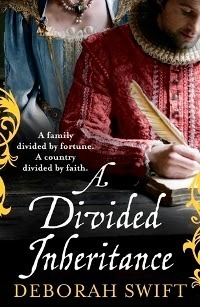 This is the third work by historical novelist Deborah Swift that I've covered on the blog, and by now I know what to expect: consummate details on daily life and artisanship in 17th-century England, rounded characters, and sensitive evocations of faith, all wound together into a steadily paced plot about honor and redemption.
This is the third work by historical novelist Deborah Swift that I've covered on the blog, and by now I know what to expect: consummate details on daily life and artisanship in 17th-century England, rounded characters, and sensitive evocations of faith, all wound together into a steadily paced plot about honor and redemption.This isn't to say the books are otherwise similar, though, because they aren't. The distinctive characters grow and change throughout the course of each one, and her plots offer plenty of surprises.
This last holds true especially for Swift’s newest release, A Divided Inheritance. It begins in early Jacobean London but wanders down to Seville partway through – which adds an exciting new dimension to the story.
Elspet Leviston is the principal heroine. A loyal daughter and smart businesswoman, she’s an indispensable part of her father Nathaniel’s lacemaking operation, but he doesn’t recognize her worth. She also has to put up with threadbare carpets in their home and overly worn gowns; despite the success of Leviston’s Lace, her father is a skinflint. Then, when a man claiming to be her cousin insinuates his way into their household, Elspet's life begins heading downhill. Zachary Deane is a cloak-snatcher and general troublemaker who has an insatiable desire to become a master swordsman, and the training he wants isn’t cheap.
Nathaniel, thrilled to have a male heir to carry on his business, has good reason to believe that Zachary is his relative. He accepts him into the family and, after Zachary gets into one too many fights, sends him on a Grand Tour across Europe. Unfortunately for all concerned, Nathaniel passes away suddenly, and the will he leaves behind favors Zachary. This sets Elspet and Zachary against one another and forces her to travel south in hopes of confronting him and regaining in full the inheritance that’s rightfully hers.
One of the taglines on the cover is “a country divided by faith,” a phrase with a double meaning. In England of 1609, four years after the Gunpowder Plot, the Catholic Levistons must conceal a priest in their home as he travels from place to place. And in Philip III’s Spain, where Elspet rejoices that she can attend mass without censure, members of the Ortega family, conversos of Muslim heritage, see their neighbors carted away for cooking meat on Friday. During these troubled times, one person’s religious liberty is another person’s oppression, and this is just one of the subtle yet effective ways this concept is illustrated.
As the novel moves along, what seems at first to be a straightforward plot turns into something much richer and deeper. A story of familial strife and deceit becomes a multifaceted tale about the consequences of religious intolerance, the expiation of guilt, the importance of family, and the appearance of unexpected love. And swordplay! The action sequences are as sharp and dazzling as Zachary’s hand-forged blade. But I’ll say no more. The unpredictable nature of the second half in particular is another strength of the book, so I’ll save the full experience for others to discover.
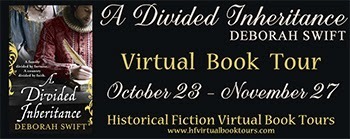
A Divided Inheritance was published by Pan Macmillan in October at £7.99 (pb, 528pp). This review forms part of the author's virtual book tour; thanks to the publisher for sending me a review copy. See also my earlier reviews for Deborah Swift's The Lady's Slipper and The Gilded Lily .
Published on November 12, 2013 05:00
November 11, 2013
Recent contest winners, and a note on cheating
Congratulations to the winners of the last two giveaways:
Daniel Kalla's Rising Sun, Falling Shadow has gone out to Lynn P.
Jenny Barden's The Lost Duchess will be going out to Katherine G.
Hope you'll enjoy the books!
Also: for the last few contests I've run, at least, it appears there's been some cheating going on. Someone who uses multiple names and owns multiple email addresses and uses them to game the system has gotten careless, entering one of my giveaways with the same email but three different names. I don't get such a huge number of entries that this isn't immediately obvious. I also noticed these same names showing up with different emails for previous contests I've run. Then when I googled one of those emails and found confirmation of the multiple aliases plus a heads-up from another blogger, well, it adds weight to the conclusions I've already drawn. This is irritating, not to mention unfair to the other entrants. Accordingly, I've removed the offender's names from the pool and will be watching closely for others in future contests.
That's all for this public service announcement; back to more book reviews tomorrow.
Daniel Kalla's Rising Sun, Falling Shadow has gone out to Lynn P.
Jenny Barden's The Lost Duchess will be going out to Katherine G.
Hope you'll enjoy the books!
Also: for the last few contests I've run, at least, it appears there's been some cheating going on. Someone who uses multiple names and owns multiple email addresses and uses them to game the system has gotten careless, entering one of my giveaways with the same email but three different names. I don't get such a huge number of entries that this isn't immediately obvious. I also noticed these same names showing up with different emails for previous contests I've run. Then when I googled one of those emails and found confirmation of the multiple aliases plus a heads-up from another blogger, well, it adds weight to the conclusions I've already drawn. This is irritating, not to mention unfair to the other entrants. Accordingly, I've removed the offender's names from the pool and will be watching closely for others in future contests.
That's all for this public service announcement; back to more book reviews tomorrow.
Published on November 11, 2013 06:56
November 8, 2013
Book review: The Signature of All Things, by Elizabeth Gilbert
Brimming with verve, wit, and intellectual curiosity, Gilbert’s absorbing epic embodies the spirit of the transformative 19th century: an age of exploration, industrial expansion, and scientific discoveries which saw people pondering the links between religion and nature. Carrying readers through this sweeping novel of ideas is a singular heroine whose life suits these big themes perfectly.
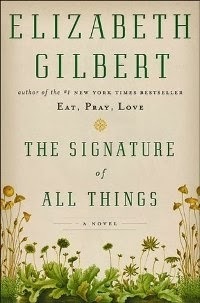 Alma Whittaker is born in 1800, the daughter of Henry, a self-made English entrepreneur whose botanical import-export firm makes him “blisteringly rich,” and his practical Dutch-born wife, Beatrix. Growing up on her father’s large, isolated Philadelphia estate, Alma spends her days studying plants, which are described in loving detail. A brilliant scholar, yet unattractive and overly tall, she abandons hope for romance until, in late middle age, she meets Ambrose Pike, a talented orchid illustrator who shifts her life’s course.
Alma Whittaker is born in 1800, the daughter of Henry, a self-made English entrepreneur whose botanical import-export firm makes him “blisteringly rich,” and his practical Dutch-born wife, Beatrix. Growing up on her father’s large, isolated Philadelphia estate, Alma spends her days studying plants, which are described in loving detail. A brilliant scholar, yet unattractive and overly tall, she abandons hope for romance until, in late middle age, she meets Ambrose Pike, a talented orchid illustrator who shifts her life’s course.
The language delights from the get-go. “His penmanship was shamefully crabbed. Each sentence was a crowded village of capital letters and small letters, living side by side in tight misery,” it says of Henry Whittaker, scribbling his account of Alma’s birth in his ledger. Likewise, its structure is refreshingly old-fashioned. As the setting moves from England to America to Tahiti and elsewhere, the author narrates Alma’s lifelong coming-of-age journey in a sprightly voice full of compassionate wisdom. Some secondary characters’ personalities are beyond eccentric, but they certainly keep things entertaining.
Without getting preachy, Gilbert reveals much that readers can take away from Alma’s experiences. Everything Alma encounters has something to teach her, from the quiet strength of mosses to her surprising realizations about family members to her own body’s desires. Over the years, she adjusts her views as needed and always soaks up new opportunities. Her story honors scientifically-minded women while demonstrating that it’s possible to create a full life despite personal disappointments. The result is a novel that’s both edifying and very satisfying.
The Signature of All Things was published by Viking in October ($28.95, hb, 512pp). The UK publisher is Bloomsbury (£18.99). This review first appeared in November's Historical Novels Review ; it was an Editors' Choice title.
 Alma Whittaker is born in 1800, the daughter of Henry, a self-made English entrepreneur whose botanical import-export firm makes him “blisteringly rich,” and his practical Dutch-born wife, Beatrix. Growing up on her father’s large, isolated Philadelphia estate, Alma spends her days studying plants, which are described in loving detail. A brilliant scholar, yet unattractive and overly tall, she abandons hope for romance until, in late middle age, she meets Ambrose Pike, a talented orchid illustrator who shifts her life’s course.
Alma Whittaker is born in 1800, the daughter of Henry, a self-made English entrepreneur whose botanical import-export firm makes him “blisteringly rich,” and his practical Dutch-born wife, Beatrix. Growing up on her father’s large, isolated Philadelphia estate, Alma spends her days studying plants, which are described in loving detail. A brilliant scholar, yet unattractive and overly tall, she abandons hope for romance until, in late middle age, she meets Ambrose Pike, a talented orchid illustrator who shifts her life’s course. The language delights from the get-go. “His penmanship was shamefully crabbed. Each sentence was a crowded village of capital letters and small letters, living side by side in tight misery,” it says of Henry Whittaker, scribbling his account of Alma’s birth in his ledger. Likewise, its structure is refreshingly old-fashioned. As the setting moves from England to America to Tahiti and elsewhere, the author narrates Alma’s lifelong coming-of-age journey in a sprightly voice full of compassionate wisdom. Some secondary characters’ personalities are beyond eccentric, but they certainly keep things entertaining.
Without getting preachy, Gilbert reveals much that readers can take away from Alma’s experiences. Everything Alma encounters has something to teach her, from the quiet strength of mosses to her surprising realizations about family members to her own body’s desires. Over the years, she adjusts her views as needed and always soaks up new opportunities. Her story honors scientifically-minded women while demonstrating that it’s possible to create a full life despite personal disappointments. The result is a novel that’s both edifying and very satisfying.
The Signature of All Things was published by Viking in October ($28.95, hb, 512pp). The UK publisher is Bloomsbury (£18.99). This review first appeared in November's Historical Novels Review ; it was an Editors' Choice title.
Published on November 08, 2013 07:00
November 6, 2013
Tomb Raider: Napoleon's Fascination with Egypt, a guest post by Anne Cleeland
Novelist Anne Cleeland is here today with an essay that explores the phenomenon of Egyptomania during the early 19th century and how it came about. Her new novel Daughter of the God-King, just out from Sourcebooks, unites mystery, adventure, and romance in the story of Miss Hattie Blackhouse, a young woman who travels from Regency England to Egypt in search of her parents and turns up a trail of secrets. Thanks to the author, I'm able to offer a giveaway at the end (US readers).
~
Tomb Raider: Napoleon's Fascination with EgyptAnne Cleeland
In the first half of the nineteenth century, Europe in general and England in particular went through a craze for all things Egyptian. Regency drawing rooms featured crocodile-legged settees and lotus blossom wallpaper, while drawing room hostesses sported jewelry that imitated the geometrical designs worn by ancient Egyptian women.
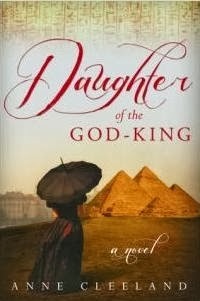 Although the wonders of ancient Egypt had been known for centuries, this particular craze was largely instigated by General Napoleon Bonaparte, a master strategist and a master propagandist. In 1797, he suggested to France’s post-revolutionary leaders that he should lead a military expedition to seize Egypt, with the treble aim of protecting France’s trade with the Orient, disrupting Britain’s trade, and opening up a sea passage similar to the modern-day Suez Canal. Unspoken was the ambitious general’s desire to be seen walking in the footsteps of Alexander the Great and indeed, one of the reasons the French approved of the expedition was to get the power-hungry and popular general out of the country for a time.
Although the wonders of ancient Egypt had been known for centuries, this particular craze was largely instigated by General Napoleon Bonaparte, a master strategist and a master propagandist. In 1797, he suggested to France’s post-revolutionary leaders that he should lead a military expedition to seize Egypt, with the treble aim of protecting France’s trade with the Orient, disrupting Britain’s trade, and opening up a sea passage similar to the modern-day Suez Canal. Unspoken was the ambitious general’s desire to be seen walking in the footsteps of Alexander the Great and indeed, one of the reasons the French approved of the expedition was to get the power-hungry and popular general out of the country for a time.
Along with his military forces, Napoleon included nearly two hundred scientists and explorers, who were tasked with cataloguing the ancient monuments and in particular, the Pharaohs’ tombs that had so captivated the public. Among other achievements, this expedition is credited with discovering the western valley in the Valley of the Kings and the famous Rosetta Stone, the key that facilitated translation of the ancient hieroglyphics. Over the next dozen years, Napoleon’s expedition created a catalog of meticulous drawings and descriptions of the monuments, tombs, and treasures—the most ambitious one to date. As a result, Egyptian fashions became all the rage.
During his time in Egypt, Napoleon took every opportunity to cement his image as a great military leader; Alexander the Great was said to have spent time alone in the King’s Chamber of the Great Pyramids, and therefore Napoleon did, also. Before the Battle of the Pyramids, when the French defeated the native Egyptian forces, Napoleon is said to have exhorted his troops to remember that forty centuries of history looked down upon them.
Napoleon’s plans came crashing down when his navy was defeated by Nelson at the Battle of the Nile, and once he realized he didn’t have the forces to conquer the area, he quietly withdrew back to France, to stir up trouble there. The legacy of his ambitions remained, though, and the ultimate irony was that most of the French-catalogued artifacts ended up in the British Museum, after the British established control in Egypt. Unfortunately for the rest of Europe, the undaunted French general then went on to other successes to offset his Egyptian setback, and the rest, as they say, is history.
 From Anne Cleeland comes the second book in her Regency adventure series—Daughter of the God-King (Sourcebooks, November 2013). The daughter of world-famous Egyptologists is living an uneventful life in England until her parents disappear while working their latest find in the Valley of the Kings. Suddenly, the various factions from Napoleon’s last war are pursuing her, and she must travel to Egypt to unravel the mystery. Along the way, she meets her parents’ enigmatic agent, who also appears to be pursuing her—although his reasons may be more personal than professional. What secret is buried in the tomb of the God-King’s daughter? The answer will change her life forever, and could set the world ablaze in yet another war. Please visit www.annecleeland.com, or see on Amazon to order.
From Anne Cleeland comes the second book in her Regency adventure series—Daughter of the God-King (Sourcebooks, November 2013). The daughter of world-famous Egyptologists is living an uneventful life in England until her parents disappear while working their latest find in the Valley of the Kings. Suddenly, the various factions from Napoleon’s last war are pursuing her, and she must travel to Egypt to unravel the mystery. Along the way, she meets her parents’ enigmatic agent, who also appears to be pursuing her—although his reasons may be more personal than professional. What secret is buried in the tomb of the God-King’s daughter? The answer will change her life forever, and could set the world ablaze in yet another war. Please visit www.annecleeland.com, or see on Amazon to order.
Anne Cleeland holds a degree in English from UCLA as well as a degree in law from Pepperdine University, and is a member of the California State Bar. She writes a contemporary mystery series set in New Scotland Yard as well as a historical fiction series set in the Regency period. A member of Mystery Writers of America and the Historical Novel Society, she lives in California and has four children. Her website is www.annecleeland.com.
~
Please fill out the form below for a chance to win a copy of Daughter of the God-King (US only). Deadline Wednesday, November 13.
Loading...
~
Tomb Raider: Napoleon's Fascination with EgyptAnne Cleeland
In the first half of the nineteenth century, Europe in general and England in particular went through a craze for all things Egyptian. Regency drawing rooms featured crocodile-legged settees and lotus blossom wallpaper, while drawing room hostesses sported jewelry that imitated the geometrical designs worn by ancient Egyptian women.
 Although the wonders of ancient Egypt had been known for centuries, this particular craze was largely instigated by General Napoleon Bonaparte, a master strategist and a master propagandist. In 1797, he suggested to France’s post-revolutionary leaders that he should lead a military expedition to seize Egypt, with the treble aim of protecting France’s trade with the Orient, disrupting Britain’s trade, and opening up a sea passage similar to the modern-day Suez Canal. Unspoken was the ambitious general’s desire to be seen walking in the footsteps of Alexander the Great and indeed, one of the reasons the French approved of the expedition was to get the power-hungry and popular general out of the country for a time.
Although the wonders of ancient Egypt had been known for centuries, this particular craze was largely instigated by General Napoleon Bonaparte, a master strategist and a master propagandist. In 1797, he suggested to France’s post-revolutionary leaders that he should lead a military expedition to seize Egypt, with the treble aim of protecting France’s trade with the Orient, disrupting Britain’s trade, and opening up a sea passage similar to the modern-day Suez Canal. Unspoken was the ambitious general’s desire to be seen walking in the footsteps of Alexander the Great and indeed, one of the reasons the French approved of the expedition was to get the power-hungry and popular general out of the country for a time. Along with his military forces, Napoleon included nearly two hundred scientists and explorers, who were tasked with cataloguing the ancient monuments and in particular, the Pharaohs’ tombs that had so captivated the public. Among other achievements, this expedition is credited with discovering the western valley in the Valley of the Kings and the famous Rosetta Stone, the key that facilitated translation of the ancient hieroglyphics. Over the next dozen years, Napoleon’s expedition created a catalog of meticulous drawings and descriptions of the monuments, tombs, and treasures—the most ambitious one to date. As a result, Egyptian fashions became all the rage.
During his time in Egypt, Napoleon took every opportunity to cement his image as a great military leader; Alexander the Great was said to have spent time alone in the King’s Chamber of the Great Pyramids, and therefore Napoleon did, also. Before the Battle of the Pyramids, when the French defeated the native Egyptian forces, Napoleon is said to have exhorted his troops to remember that forty centuries of history looked down upon them.
Napoleon’s plans came crashing down when his navy was defeated by Nelson at the Battle of the Nile, and once he realized he didn’t have the forces to conquer the area, he quietly withdrew back to France, to stir up trouble there. The legacy of his ambitions remained, though, and the ultimate irony was that most of the French-catalogued artifacts ended up in the British Museum, after the British established control in Egypt. Unfortunately for the rest of Europe, the undaunted French general then went on to other successes to offset his Egyptian setback, and the rest, as they say, is history.
 From Anne Cleeland comes the second book in her Regency adventure series—Daughter of the God-King (Sourcebooks, November 2013). The daughter of world-famous Egyptologists is living an uneventful life in England until her parents disappear while working their latest find in the Valley of the Kings. Suddenly, the various factions from Napoleon’s last war are pursuing her, and she must travel to Egypt to unravel the mystery. Along the way, she meets her parents’ enigmatic agent, who also appears to be pursuing her—although his reasons may be more personal than professional. What secret is buried in the tomb of the God-King’s daughter? The answer will change her life forever, and could set the world ablaze in yet another war. Please visit www.annecleeland.com, or see on Amazon to order.
From Anne Cleeland comes the second book in her Regency adventure series—Daughter of the God-King (Sourcebooks, November 2013). The daughter of world-famous Egyptologists is living an uneventful life in England until her parents disappear while working their latest find in the Valley of the Kings. Suddenly, the various factions from Napoleon’s last war are pursuing her, and she must travel to Egypt to unravel the mystery. Along the way, she meets her parents’ enigmatic agent, who also appears to be pursuing her—although his reasons may be more personal than professional. What secret is buried in the tomb of the God-King’s daughter? The answer will change her life forever, and could set the world ablaze in yet another war. Please visit www.annecleeland.com, or see on Amazon to order. Anne Cleeland holds a degree in English from UCLA as well as a degree in law from Pepperdine University, and is a member of the California State Bar. She writes a contemporary mystery series set in New Scotland Yard as well as a historical fiction series set in the Regency period. A member of Mystery Writers of America and the Historical Novel Society, she lives in California and has four children. Her website is www.annecleeland.com.
~
Please fill out the form below for a chance to win a copy of Daughter of the God-King (US only). Deadline Wednesday, November 13.
Loading...
Published on November 06, 2013 05:00
November 3, 2013
Book review: Elisabeth Storrs' The Golden Dice, an epic novel of ancient Rome and Etruria
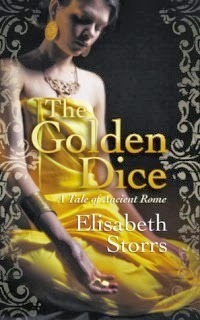 What's it like to be known as your country’s Helen of Troy? For Aemilia Caeciliana, called Caecilia, it means that her native Rome considers her the enemy, while the people of her adopted city of Veii in Etruria, her husband’s homeland, will distrust her no matter how many warrior sons she bears.
What's it like to be known as your country’s Helen of Troy? For Aemilia Caeciliana, called Caecilia, it means that her native Rome considers her the enemy, while the people of her adopted city of Veii in Etruria, her husband’s homeland, will distrust her no matter how many warrior sons she bears. With Caecilia, one of three heroines of Elisabeth Storrs’ gripping epic of the ancient world, political matters have always had serious personal consequences, and vice versa. Her loving marriage may be mythologized as the capstone to an adventurous star-crossed romance, but there are two sides to her situation, and her uneasy plight can't help but evoke sympathy.
“The similarity of her own story to the Greek girl's always disturbed her,” Storrs tells us in thoughtful prose. “This morning her son had been enthralled by his parents’ story also. One day, though... he might see her as a traitoress who started a never-ending war.”
Opening in 399 BC, The Golden Dice takes place seven years into the Roman siege of Veii, an event allegedly sparked by Caecilia’s decision to return to her husband, Etruscan general Vel Mastarna. Originally given to Mastarna as a “treaty bride,” an event recounted in The Wedding Shroud, she had fallen in love with him and chose him over Rome even after the truce between their rival lands broke down – a betrayal neither city can accept. In reality, though, Rome has always coveted the abundant grain-producing Veientane lands and uses her defection as an excuse to wage war.
This second volume in the series offers a much wider view of the era than the first, and is an even stronger book as a result. Storrs introduces two intriguing new heroines who share the pages with Caecilia and whose lives come to overlap closely with hers. Semni, a 15-year-old potter in the Mastarna household’s workshop, finds that her promiscuity and poor decisions get in the way of a possible romance. And Pinna, a Roman tomb whore and hired mourner, uses all the tools she has, blackmail included, to escape poverty and become an accepted member of society. Their stories, while captivating in their own right, also present Caecilia and her family from angles not previously seen.
Caecilia and Pinna may be opposites in political allegiance and social status, but the novel makes clear that during these tense, trying circumstances, both women have everything to lose. Political forces are shifting in both Rome and Veii, and the Romans’ decision to wage war in winter increases the level of danger and raises the stakes for all three women and those they love.
Veii no longer feels as much like an alien place as it did in The Wedding Shroud. Caecilia is now a Rasennan matron, to use the adjective the Etruscans use for themselves, and has established a few good friendships. As such, many of its customs have become familiar and even welcome, the freedoms offered to women especially. This stands in contrast to Rome, where, as Pinna notes, “a girl’s existence was only officially recorded on her wedding day.”
However, the horrific rituals of the Calu Death Cult of Veii, to give just one example, mean that its culture will always retain some of its foreignness. Caecilia detests those rites and still misses her cousin Marcus back in Rome, hoping he feels the same way. (He doesn't.) While she loves her husband and children, neither civilization is a truly comfortable place.
The novel interweaves scenes of domesticity with those of politics, war, religious observances, and love and brings them all to life beautifully; none of these elements overwhelms the others. There aren’t many novels of the Roman world that provide such a comprehensive picture, which should give The Golden Dice great appeal for a variety of readers.
Whether seen from the viewpoint of soldiers on the field, or by Caecilia glimpsing the bloodshed from atop the high walls of Veii, the battle action is fierce and intense. It also serves the greater purpose of developing character. Moreover, Storrs' writing is just as dramatically powerful in its quieter moments. She creates a haunting picture of a desperate young woman pondering her past and future amidst the Roman tombs at night, to name one memorable instance, as well as many heartfelt images evoking a mother's protectiveness of her child.
~
The Golden Dice was published in July by Cornelian Press in paperback ($14.00) and on Kindle. There's a promotion currently running until the end of Monday, November 4th, in which the Kindle version is priced at 99 cents. For more info, see the author's website at www.elisabethstorrs.com, my earlier review of The Wedding Shroud, and her previous guest posts on feminine power within Etruscan society and approaching Ursula Le Guin for an endorsement via snail mail.
Published on November 03, 2013 15:00
November 1, 2013
‘When Eden became Hell’ – the vision and plight of the first ‘Lost’ Colonists of Roanoke, a guest post by Jenny Barden
Jenny Barden, author of The Lost Duchess, is stopping by with an essay centering on what is perhaps the oldest unsolved mystery in American history: the unknown fate of the Roanoke colonists. Using excerpts from primary sources of the time, she looks even further back to the colony's origins as a "land of plentie" and examines how this most promising of beginnings turned into disaster. The photos included below were taken by Jenny during her research travels for the book, and the map of Raleigh's Virginia is also of her own design.
Thanks to the generosity of the author, I'm able to offer a giveaway of a signed first edition hardcover to a lucky blog reader - see the entry form at the end of the post. This contest is open worldwide.
~
‘When Eden Became Hell’ – The Vision and Plight of the First ‘Lost’ Colonists of Roanoke Jenny Barden
The east coast of America was described in terms of wonder by Arthur Barlowe when he returned to England after his voyage of discovery in 1584. He wrote about taking possession in the name of Queen Elizabeth of the region now known as the Outer Banks of North Carolina and viewing it as: ‘So full of grapes, as the very beating, and surge of the Sea overflowed them, of which we founde such plenty… on the greene soile on the hils, and in the plaines, as well on every little shrubbe, as also climbing towards the toppes of the high Cedars, that I thinke in all the world the like aboundance is not to be founde.’
 Ocracoke Shore - the scene at first arrival.
Ocracoke Shore - the scene at first arrival.
Barlowe described the native Algonquian Indians he encountered as: ‘most gentle, loving, and faithfull, void of all guile, and treason, and such as lived after the manner of the golden age.’ He was taken to the Island of Roanoke, behind the outer barrier islands, and entertained with every courtesy. Of this place he wrote: ‘The earth bringeth foorth all things in aboundance, as in the first creation, without toile or labour.’
 Abundance - beach evening primrose on Hatteras Island
Abundance - beach evening primrose on Hatteras Island
Inspired by this report, and motivated by a desire to emulate and curb Spain’s New World expansion, seize commercial advantage for England, as well as spread Christian enlightenment of the Protestant kind, Richard Hakluyt the younger wrote his ‘Discourse of Western Planting’ (meaning ‘planting’ English colonies) in which he extolled the wisdom of royal investment in another expedition and promised that ‘this westerne voyadge will yelde unto us all the commodities of Europe, Affrica, and Asia.’ He encouraged Walter Raleigh to lead the drive to establish English settlements in America for the glory of God and the Queen, and though Raleigh failed to extract the hoped for financial support, the Virgin Queen honoured him with a knighthood for championing her cause in the newly named ‘Virginia’. Two more voyages followed, with the aim of establishing a stronghold in the region, one which Hakluyt described as: ‘This paradise of the worlde.’
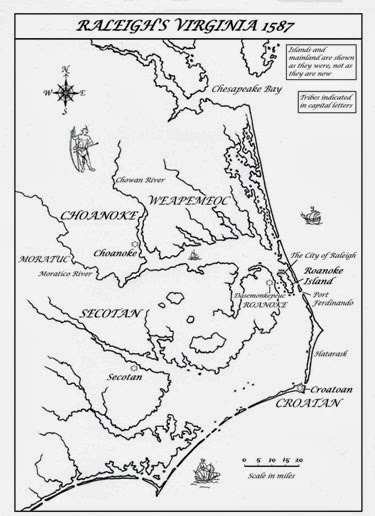
So when Raleigh’s colonists were recruited to form a permanent English settlement in Virginia under the governorship of John White (former expedition observer and a talented artist) they were charmed with the promise of going to a Garden of Delights – a new Eden where the living would be easy. Women and children were enlisted too, and men with the practical skills to create an enduring community, many of them tempted by the prospect of owning 500 acres of prime farmland. For a novelist, the resonance of this is compelling – these were people expecting to find a Promised Land; they were to be cruelly disappointed. Virginia was the Paradise that was to become Paradise Lost.
Grim reality only dawned on the settlers gradually. At first, on arrival in the summer of 1587, they were confronted with no more than a mystery, one of many mysteries that swept over Roanoke with successive attempts to put down English roots there, as if the landscape was periodically swept clean of invaders as effectively as by one of the hurricanes that are an ever present threat, leaving only sand and a few tantalising traces. We ‘walked to the North ende of the Island,’ wrote John White, ‘where Master Ralfe Lane had his forte, with sundry necessarie and decent dwelling houses, made by his men about it the yeere before, where wee hoped to finde some signes, or certaine knowledge of our fifteene men’ (meaning the men subsequently left by Sir Richard Grenville). ‘When we came thither, wee found the forte rased downe, but all the houses standing unhurt, saving the neather roomes of them, and also of the forte, were overgrowen with Melons of divers sortes, and Deere within them, feeding on those Mellons.’
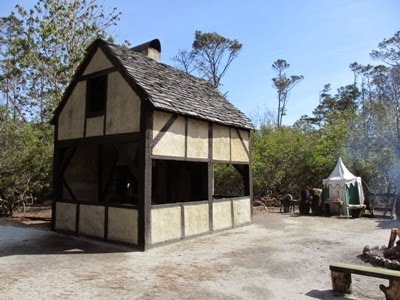 Reconstruction at Roanoke Island Festival Park
Reconstruction at Roanoke Island Festival Park
That stark description brings the scene to life: the image of tranquillity overlaying signs of disaster – deer feeding on melons which had overgrown a ruined fort and abandoned houses. What had happened? White only began to find out after the bones of ‘one of those fifteene’ were discovered, ‘which the Savages had slaine long before,’ and one of the colonists was brutally murdered a few days later. The man’s body was found shot through with arrows with his head beaten ‘in peeces’ by wooden swords. He had been wading alone in the shallows not long after arrival, ‘almost naked’ equipped only with a forked stick for crabbing: a picture of someone relaxed and oblivious to danger who encountered horrific violence without any warning. The friendly Croatan tribe eventually provided an explanation by accusing the Roanoke tribe and others led by Wanchese for both crimes.
Here the mystery within a mystery becomes even more intriguing because Wanchese was one of two Indians brought back to England by the Barlowe expedition; the other was Manteo, who returned to England twice and became a loyal ally. But as much as Manteo’s love for the English grew, Wanchese’s hatred deepened, and his knowledge of English ways only made him more effective as an enemy. If Virginia was once an Eden, in these two, perhaps, we can see a mirror of Cain and Abel: two brothers in race, one murderously turning on the other with catastrophic consequences.
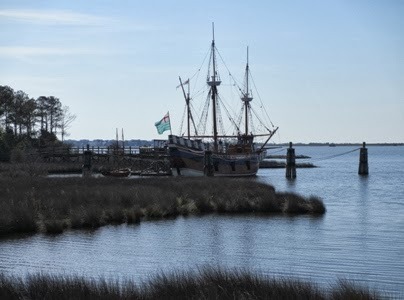 The Elizabeth at Roanoke
The Elizabeth at Roanoke
The true story has endless fascination for its parallels and significance, and it provides rich material for a novelist not least because the real conclusion remains unknown. This is the larger mystery. White left Virginia less than six weeks after arriving and was unable to return for three years; when he did, he found Roanoke Island deserted and bad weather curtailed any attempt at widening the search. The fate of the ‘Lost Colony’ has remained an enigma ever since. White returned to England and died never knowing what had become of his daughter, Eleanor, or his grand-daughter, Virginia Dare, the first child of English parents to be born in America. ‘My last voyage to Virginia… was no less unfortunately ended than forwardly begun,’ he wrote to Richard Hakluyt in February 1593, ‘I leave off from prosecuting that whereunto I would to God my wealth were answerable to my will.’
For the colonists left on Roanoke their predicament must have been truly terrifying. Short of food and surrounded by hostile native tribes, they would have faced a dire dilemma – to remain behind their defences, in their houses, and try to fend off likely Indian attack whilst eking out an existence through the winter with the supplies that remained to them – or relocate to another area where they would have had to start from scratch, improvising shelters, and face even greater uncertainty in finding sustenance and friendship with other native tribes. Perhaps they went to Croatoan, which was where the signs found by White suggested they had fled (though their allies were known to have no food to spare). Perhaps they crammed into the pinnace and the few boats left to them and made for Chesapeake Bay area (which was their intended destination before the expedition pilot insisted that they disembark at Roanoke). Possibly they made for some other site inland, such as the base marked with a cryptic fort symbol for centuries hidden under a patch on White’s Virginea Pars map.* They might even have tried to sail back to England. We’ll probably never know for certain which course of action they took.
 Bald CypressWhat had happened to turn the ‘gentle, loving’ Indians into fearsome enemies? The Lost Colonists seem to have been unaware of what Ralph Lane’s men had done to alienate Wanchese and his followers, but there is little doubt that the Roanoke and Choanoke tribes had good cause to feel bitter. Problems began with the constant demands for food from Lane’s garrison, manageable at first, but not so easily dealt with after the poor harvest that followed Lane’s arrival – his men were soldiers, unused to providing for themselves. The Indians were also upset that the English (whom many believed to be dead men reincarnated) appeared to have the power to wipe out whole villages by magic (the Indians began to die after contracting mysterious diseases – probably measles and smallpox that the newcomers brought with them).
Bald CypressWhat had happened to turn the ‘gentle, loving’ Indians into fearsome enemies? The Lost Colonists seem to have been unaware of what Ralph Lane’s men had done to alienate Wanchese and his followers, but there is little doubt that the Roanoke and Choanoke tribes had good cause to feel bitter. Problems began with the constant demands for food from Lane’s garrison, manageable at first, but not so easily dealt with after the poor harvest that followed Lane’s arrival – his men were soldiers, unused to providing for themselves. The Indians were also upset that the English (whom many believed to be dead men reincarnated) appeared to have the power to wipe out whole villages by magic (the Indians began to die after contracting mysterious diseases – probably measles and smallpox that the newcomers brought with them).
Eventually, the chief of the Roanoke tribe, Wingina, took his base from the island to the mainland, severed communications, and destroyed the Indian fishtraps that the English had come to depend upon. In the ‘land of plentie’, Lane’s men were reduced to scavenging for shellfish and berries. Fearing attack while in a weakened state, Lane decided to strike first. He claimed to have discovered a plot to annihilate the English from the son of the king of the Choanokes whom Lane held as a prisoner.
Lane took control of all the boats and canoes on Roanoke, killed as many of the island Indians as he could find, rowed across to the mainland and asked for a council with Wingina, then fired on the unsuspecting chief and his elders. Though wounded, Wingina escaped into the forest, but was tracked, captured and decapitated. Lane later wrote: ‘Others were busie that none of the rest should escape.’
A few days after the massacre, Sir Francis Drake arrived on his way back from the sacking of Santo Domingo and raiding Spanish forts in Florida. Drake offered relief, then, after a wrecking storm blew up, evacuated Lane’s entire garrison. Lane was spared having to face the wrath of the Indians intent on vengeance for his depredations – that burden was to fall on Grenville’s fifteen and the Lost Colonists. The ‘paradise of the worlde’ had effectively been poisoned – Eden had become Hell.
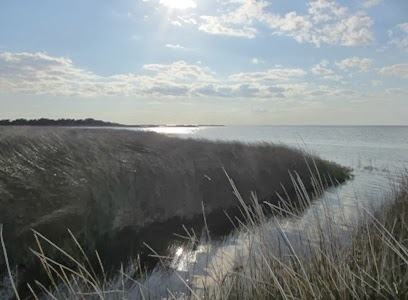 Roanoke mud flats
Roanoke mud flats
* This patch came to media attention on both sides of the Atlantic last year when it was found to mask a fort-like icon: see articles in the New York Times and Telegraph .
** Quotations are from the original accounts as reproduced in The First Colonists: Documents on the Planting of the First Settlements in North America 1584-1590, edited by DB Quinn and AM Quinn
*** All pictures copyright Jenny Barden
~
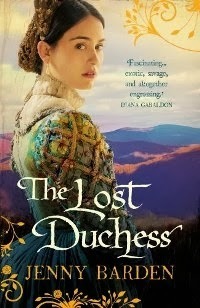 Jenny Barden's second novel, The Lost Duchess (Ebury Press/Random House UK), an epic Elizabethan adventure-love story set against the backdrop of Raleigh's 'Lost Colony' of Roanoke, will be released on 7 November and can be pre-ordered from Amazon UK.
Jenny Barden's second novel, The Lost Duchess (Ebury Press/Random House UK), an epic Elizabethan adventure-love story set against the backdrop of Raleigh's 'Lost Colony' of Roanoke, will be released on 7 November and can be pre-ordered from Amazon UK.
Emme Fifield has fallen about as far as a gentlewoman can.
Once a lady-in-waiting to Queen Elizabeth, her only hope of surviving the scandal that threatens to engulf her is to escape England for a fresh start in the new America where nobody has ever heard of the Duchess of Somerset.
Emme joins Kit Doonan's rag-tag band of idealists, desperados and misfits bound for Virginia. But such a voyage will be far from easy and Emme finds her attraction to the mysterious Doonan inconvenient to say the least.
As for Kit, the handsome mariner has spent years imprisoned by the Spanish, and living as an outlaw with a band of escaped slaves; he has his own inner demons to confront, and his own dark secrets to keep...
Ever since Sir Walter Raleigh's settlement in Virginia was abandoned in 1587 its fate has remained a mystery; The Lost Duchess explores what might have happened to the ill-starred 'Lost Colony' of Roanoke.
More about Jenny and her books can be found on her website: www.jennybarden.com.
~
Please fill out the following form for a chance to win a signed first edition hardcover of The Lost Duchess. Open worldwide. Deadline Saturday, November 10th. Good luck!
Loading...
Thanks to the generosity of the author, I'm able to offer a giveaway of a signed first edition hardcover to a lucky blog reader - see the entry form at the end of the post. This contest is open worldwide.
~
‘When Eden Became Hell’ – The Vision and Plight of the First ‘Lost’ Colonists of Roanoke Jenny Barden
The east coast of America was described in terms of wonder by Arthur Barlowe when he returned to England after his voyage of discovery in 1584. He wrote about taking possession in the name of Queen Elizabeth of the region now known as the Outer Banks of North Carolina and viewing it as: ‘So full of grapes, as the very beating, and surge of the Sea overflowed them, of which we founde such plenty… on the greene soile on the hils, and in the plaines, as well on every little shrubbe, as also climbing towards the toppes of the high Cedars, that I thinke in all the world the like aboundance is not to be founde.’
 Ocracoke Shore - the scene at first arrival.
Ocracoke Shore - the scene at first arrival.Barlowe described the native Algonquian Indians he encountered as: ‘most gentle, loving, and faithfull, void of all guile, and treason, and such as lived after the manner of the golden age.’ He was taken to the Island of Roanoke, behind the outer barrier islands, and entertained with every courtesy. Of this place he wrote: ‘The earth bringeth foorth all things in aboundance, as in the first creation, without toile or labour.’
 Abundance - beach evening primrose on Hatteras Island
Abundance - beach evening primrose on Hatteras IslandInspired by this report, and motivated by a desire to emulate and curb Spain’s New World expansion, seize commercial advantage for England, as well as spread Christian enlightenment of the Protestant kind, Richard Hakluyt the younger wrote his ‘Discourse of Western Planting’ (meaning ‘planting’ English colonies) in which he extolled the wisdom of royal investment in another expedition and promised that ‘this westerne voyadge will yelde unto us all the commodities of Europe, Affrica, and Asia.’ He encouraged Walter Raleigh to lead the drive to establish English settlements in America for the glory of God and the Queen, and though Raleigh failed to extract the hoped for financial support, the Virgin Queen honoured him with a knighthood for championing her cause in the newly named ‘Virginia’. Two more voyages followed, with the aim of establishing a stronghold in the region, one which Hakluyt described as: ‘This paradise of the worlde.’

So when Raleigh’s colonists were recruited to form a permanent English settlement in Virginia under the governorship of John White (former expedition observer and a talented artist) they were charmed with the promise of going to a Garden of Delights – a new Eden where the living would be easy. Women and children were enlisted too, and men with the practical skills to create an enduring community, many of them tempted by the prospect of owning 500 acres of prime farmland. For a novelist, the resonance of this is compelling – these were people expecting to find a Promised Land; they were to be cruelly disappointed. Virginia was the Paradise that was to become Paradise Lost.
Grim reality only dawned on the settlers gradually. At first, on arrival in the summer of 1587, they were confronted with no more than a mystery, one of many mysteries that swept over Roanoke with successive attempts to put down English roots there, as if the landscape was periodically swept clean of invaders as effectively as by one of the hurricanes that are an ever present threat, leaving only sand and a few tantalising traces. We ‘walked to the North ende of the Island,’ wrote John White, ‘where Master Ralfe Lane had his forte, with sundry necessarie and decent dwelling houses, made by his men about it the yeere before, where wee hoped to finde some signes, or certaine knowledge of our fifteene men’ (meaning the men subsequently left by Sir Richard Grenville). ‘When we came thither, wee found the forte rased downe, but all the houses standing unhurt, saving the neather roomes of them, and also of the forte, were overgrowen with Melons of divers sortes, and Deere within them, feeding on those Mellons.’
 Reconstruction at Roanoke Island Festival Park
Reconstruction at Roanoke Island Festival ParkThat stark description brings the scene to life: the image of tranquillity overlaying signs of disaster – deer feeding on melons which had overgrown a ruined fort and abandoned houses. What had happened? White only began to find out after the bones of ‘one of those fifteene’ were discovered, ‘which the Savages had slaine long before,’ and one of the colonists was brutally murdered a few days later. The man’s body was found shot through with arrows with his head beaten ‘in peeces’ by wooden swords. He had been wading alone in the shallows not long after arrival, ‘almost naked’ equipped only with a forked stick for crabbing: a picture of someone relaxed and oblivious to danger who encountered horrific violence without any warning. The friendly Croatan tribe eventually provided an explanation by accusing the Roanoke tribe and others led by Wanchese for both crimes.
Here the mystery within a mystery becomes even more intriguing because Wanchese was one of two Indians brought back to England by the Barlowe expedition; the other was Manteo, who returned to England twice and became a loyal ally. But as much as Manteo’s love for the English grew, Wanchese’s hatred deepened, and his knowledge of English ways only made him more effective as an enemy. If Virginia was once an Eden, in these two, perhaps, we can see a mirror of Cain and Abel: two brothers in race, one murderously turning on the other with catastrophic consequences.
 The Elizabeth at Roanoke
The Elizabeth at RoanokeThe true story has endless fascination for its parallels and significance, and it provides rich material for a novelist not least because the real conclusion remains unknown. This is the larger mystery. White left Virginia less than six weeks after arriving and was unable to return for three years; when he did, he found Roanoke Island deserted and bad weather curtailed any attempt at widening the search. The fate of the ‘Lost Colony’ has remained an enigma ever since. White returned to England and died never knowing what had become of his daughter, Eleanor, or his grand-daughter, Virginia Dare, the first child of English parents to be born in America. ‘My last voyage to Virginia… was no less unfortunately ended than forwardly begun,’ he wrote to Richard Hakluyt in February 1593, ‘I leave off from prosecuting that whereunto I would to God my wealth were answerable to my will.’
For the colonists left on Roanoke their predicament must have been truly terrifying. Short of food and surrounded by hostile native tribes, they would have faced a dire dilemma – to remain behind their defences, in their houses, and try to fend off likely Indian attack whilst eking out an existence through the winter with the supplies that remained to them – or relocate to another area where they would have had to start from scratch, improvising shelters, and face even greater uncertainty in finding sustenance and friendship with other native tribes. Perhaps they went to Croatoan, which was where the signs found by White suggested they had fled (though their allies were known to have no food to spare). Perhaps they crammed into the pinnace and the few boats left to them and made for Chesapeake Bay area (which was their intended destination before the expedition pilot insisted that they disembark at Roanoke). Possibly they made for some other site inland, such as the base marked with a cryptic fort symbol for centuries hidden under a patch on White’s Virginea Pars map.* They might even have tried to sail back to England. We’ll probably never know for certain which course of action they took.
 Bald CypressWhat had happened to turn the ‘gentle, loving’ Indians into fearsome enemies? The Lost Colonists seem to have been unaware of what Ralph Lane’s men had done to alienate Wanchese and his followers, but there is little doubt that the Roanoke and Choanoke tribes had good cause to feel bitter. Problems began with the constant demands for food from Lane’s garrison, manageable at first, but not so easily dealt with after the poor harvest that followed Lane’s arrival – his men were soldiers, unused to providing for themselves. The Indians were also upset that the English (whom many believed to be dead men reincarnated) appeared to have the power to wipe out whole villages by magic (the Indians began to die after contracting mysterious diseases – probably measles and smallpox that the newcomers brought with them).
Bald CypressWhat had happened to turn the ‘gentle, loving’ Indians into fearsome enemies? The Lost Colonists seem to have been unaware of what Ralph Lane’s men had done to alienate Wanchese and his followers, but there is little doubt that the Roanoke and Choanoke tribes had good cause to feel bitter. Problems began with the constant demands for food from Lane’s garrison, manageable at first, but not so easily dealt with after the poor harvest that followed Lane’s arrival – his men were soldiers, unused to providing for themselves. The Indians were also upset that the English (whom many believed to be dead men reincarnated) appeared to have the power to wipe out whole villages by magic (the Indians began to die after contracting mysterious diseases – probably measles and smallpox that the newcomers brought with them).Eventually, the chief of the Roanoke tribe, Wingina, took his base from the island to the mainland, severed communications, and destroyed the Indian fishtraps that the English had come to depend upon. In the ‘land of plentie’, Lane’s men were reduced to scavenging for shellfish and berries. Fearing attack while in a weakened state, Lane decided to strike first. He claimed to have discovered a plot to annihilate the English from the son of the king of the Choanokes whom Lane held as a prisoner.
Lane took control of all the boats and canoes on Roanoke, killed as many of the island Indians as he could find, rowed across to the mainland and asked for a council with Wingina, then fired on the unsuspecting chief and his elders. Though wounded, Wingina escaped into the forest, but was tracked, captured and decapitated. Lane later wrote: ‘Others were busie that none of the rest should escape.’
A few days after the massacre, Sir Francis Drake arrived on his way back from the sacking of Santo Domingo and raiding Spanish forts in Florida. Drake offered relief, then, after a wrecking storm blew up, evacuated Lane’s entire garrison. Lane was spared having to face the wrath of the Indians intent on vengeance for his depredations – that burden was to fall on Grenville’s fifteen and the Lost Colonists. The ‘paradise of the worlde’ had effectively been poisoned – Eden had become Hell.
 Roanoke mud flats
Roanoke mud flats* This patch came to media attention on both sides of the Atlantic last year when it was found to mask a fort-like icon: see articles in the New York Times and Telegraph .
** Quotations are from the original accounts as reproduced in The First Colonists: Documents on the Planting of the First Settlements in North America 1584-1590, edited by DB Quinn and AM Quinn
*** All pictures copyright Jenny Barden
~
 Jenny Barden's second novel, The Lost Duchess (Ebury Press/Random House UK), an epic Elizabethan adventure-love story set against the backdrop of Raleigh's 'Lost Colony' of Roanoke, will be released on 7 November and can be pre-ordered from Amazon UK.
Jenny Barden's second novel, The Lost Duchess (Ebury Press/Random House UK), an epic Elizabethan adventure-love story set against the backdrop of Raleigh's 'Lost Colony' of Roanoke, will be released on 7 November and can be pre-ordered from Amazon UK.Emme Fifield has fallen about as far as a gentlewoman can.
Once a lady-in-waiting to Queen Elizabeth, her only hope of surviving the scandal that threatens to engulf her is to escape England for a fresh start in the new America where nobody has ever heard of the Duchess of Somerset.
Emme joins Kit Doonan's rag-tag band of idealists, desperados and misfits bound for Virginia. But such a voyage will be far from easy and Emme finds her attraction to the mysterious Doonan inconvenient to say the least.
As for Kit, the handsome mariner has spent years imprisoned by the Spanish, and living as an outlaw with a band of escaped slaves; he has his own inner demons to confront, and his own dark secrets to keep...
Ever since Sir Walter Raleigh's settlement in Virginia was abandoned in 1587 its fate has remained a mystery; The Lost Duchess explores what might have happened to the ill-starred 'Lost Colony' of Roanoke.
More about Jenny and her books can be found on her website: www.jennybarden.com.
~
Please fill out the following form for a chance to win a signed first edition hardcover of The Lost Duchess. Open worldwide. Deadline Saturday, November 10th. Good luck!
Loading...
Published on November 01, 2013 22:00
October 31, 2013
Historical novels for the WWI centenary: A gallery of new and forthcoming titles, part 2
And, finally, here's the second part of my gallery of new and forthcoming historical novels centered around World War I. Part 1 can be found here. This list is longer than originally intended – 11 titles instead of 8 – because more relevant books kept coming to light.

A novel of love, war, and redemption beginning in 1914, when a man delivers a letter to the woman he loves and learns its heartbreaking contents. Set in England's Cumberland fells and overseas. The Borough Press (HarperCollins UK), January 2014.

In 1920, a man from Cornwall left alone and bereft after his wartime experiences finds that a lie told in his past has unavoidable and devastating repercussions. A story of love, loss, and the life-changing relationship between two young soldiers, only one of whom lives to return home. Thanks to Sarah OL for calling this one to my attention! Hutchinson (UK), January 2014; Atlantic Monthly (US), April 2014.
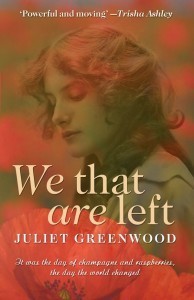
A privileged young wife on a large Cornwall estate gains responsibility and confidence when her husband leaves to fight overseas. This English home front saga then becomes something more when she leaves for France herself to rescue a friend from danger. Honno Welsh Women's Press, February 2014.

A new Jojo Moyes novel I haven't read... yet... but I will. (I bought a copy a year ago in London, too.) Her The Last Letter from Your Lover was both a cleverly constructed mystery and a totally absorbing emotional read, so I have high hopes for this one. The Girl You Left Behind is a dual-period novel about a young Frenchwoman in 1916, her artist husband, a German Kommandant, and a portrait whose mysterious legacy lies undiscovered for a century. Penguin UK, September 2012; Viking US, August 2013.

In Robson's debut, a young Englishwoman flees the constraints of her aristocratic life by joining the Women's Army Auxiliary Corps and, while serving in France, falls in love with her brother's Scottish best friend, a surgeon not of her social station. William Morrow, January 2014.
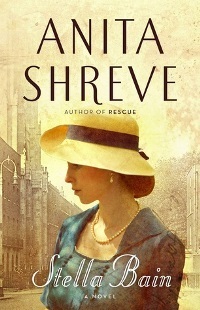
In her new literary novel about war, memories, identity, and revisiting the pain of the past, Shreve unfolds the mysterious history of an American woman who served as a nurse's aide on the battlefields of France but can remember little else about who she is. She travels to London, where the surgeon who takes her in develops a clinical interest in her case. Beautiful cover design. Little Brown, November 2013.
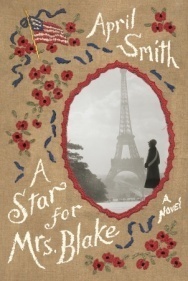
The Gold Star Mothers Club was an organization founded after WWI to support mothers who lost children in the war; I hadn't know that before coming across this title. Smith's work of literary fiction visits the stories of five American women, all mothers of sons who died in the war, who travel overseas to Verdun in 1930, establishing connections and learning shocking truths. Knopf, January 2014.
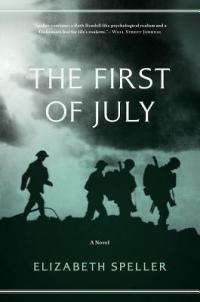
Four very different young men fighting on the side of the Allies won't ever be the same after July 1st, 1916, the first day of the devastating bloodbath that was the Battle of the Somme. It's been getting early rave reviews as a haunting military narrative. Pegasus, November 2013. Be aware that the UK edition has a different title, A Break of Day (Virago, also Nov).

St. James' third Gothic historical novel about the ghosts of wartime past takes place on an isolated northern English estate that's been turned into a hospital for shell-shocked soldiers. When Kitty Weekes arrives there to work, pretending to be a nurse, the tormented patients aren't her only concern. Is Portis House haunted, and what became of the German family who once lived there? NAL, April 2014.
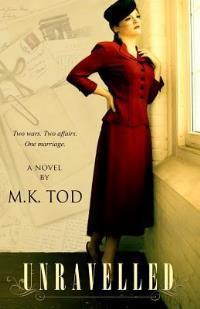
I was pleased to have the opportunity to endorse this engrossing historical saga. With narrative insight, compassion, and a strong sense of time and place, M.K. Tod observes the inner workings of a marriage as it’s affected by the uncertainty and tumult of both world wars. (Hope you don't mind if I repeat my words here...) You may know Mary Tod from her blog, A Writer of History, or from her series of surveys of historical fiction readers. Tod Publishing, September 2013.
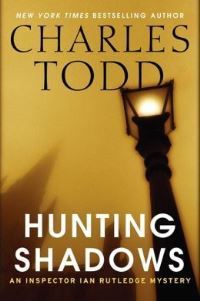
First, a thanks to HarperCollins for giving me early access to Charles Todd's latest mystery via Edelweiss. I read it with rapt attention. It fits the high standard expected of a historical mystery featuring troubled Scotland Yard detective Ian Rutledge, who this time is sent in 1920 to investigate two inexplicable murders in and around Ely in Cambridgeshire. Can the answers be found by delving into wartime secrets? The resolution took some twists I didn't expect, which I like. William Morrow, January 2014.

A novel of love, war, and redemption beginning in 1914, when a man delivers a letter to the woman he loves and learns its heartbreaking contents. Set in England's Cumberland fells and overseas. The Borough Press (HarperCollins UK), January 2014.

In 1920, a man from Cornwall left alone and bereft after his wartime experiences finds that a lie told in his past has unavoidable and devastating repercussions. A story of love, loss, and the life-changing relationship between two young soldiers, only one of whom lives to return home. Thanks to Sarah OL for calling this one to my attention! Hutchinson (UK), January 2014; Atlantic Monthly (US), April 2014.

A privileged young wife on a large Cornwall estate gains responsibility and confidence when her husband leaves to fight overseas. This English home front saga then becomes something more when she leaves for France herself to rescue a friend from danger. Honno Welsh Women's Press, February 2014.

A new Jojo Moyes novel I haven't read... yet... but I will. (I bought a copy a year ago in London, too.) Her The Last Letter from Your Lover was both a cleverly constructed mystery and a totally absorbing emotional read, so I have high hopes for this one. The Girl You Left Behind is a dual-period novel about a young Frenchwoman in 1916, her artist husband, a German Kommandant, and a portrait whose mysterious legacy lies undiscovered for a century. Penguin UK, September 2012; Viking US, August 2013.

In Robson's debut, a young Englishwoman flees the constraints of her aristocratic life by joining the Women's Army Auxiliary Corps and, while serving in France, falls in love with her brother's Scottish best friend, a surgeon not of her social station. William Morrow, January 2014.

In her new literary novel about war, memories, identity, and revisiting the pain of the past, Shreve unfolds the mysterious history of an American woman who served as a nurse's aide on the battlefields of France but can remember little else about who she is. She travels to London, where the surgeon who takes her in develops a clinical interest in her case. Beautiful cover design. Little Brown, November 2013.

The Gold Star Mothers Club was an organization founded after WWI to support mothers who lost children in the war; I hadn't know that before coming across this title. Smith's work of literary fiction visits the stories of five American women, all mothers of sons who died in the war, who travel overseas to Verdun in 1930, establishing connections and learning shocking truths. Knopf, January 2014.

Four very different young men fighting on the side of the Allies won't ever be the same after July 1st, 1916, the first day of the devastating bloodbath that was the Battle of the Somme. It's been getting early rave reviews as a haunting military narrative. Pegasus, November 2013. Be aware that the UK edition has a different title, A Break of Day (Virago, also Nov).

St. James' third Gothic historical novel about the ghosts of wartime past takes place on an isolated northern English estate that's been turned into a hospital for shell-shocked soldiers. When Kitty Weekes arrives there to work, pretending to be a nurse, the tormented patients aren't her only concern. Is Portis House haunted, and what became of the German family who once lived there? NAL, April 2014.

I was pleased to have the opportunity to endorse this engrossing historical saga. With narrative insight, compassion, and a strong sense of time and place, M.K. Tod observes the inner workings of a marriage as it’s affected by the uncertainty and tumult of both world wars. (Hope you don't mind if I repeat my words here...) You may know Mary Tod from her blog, A Writer of History, or from her series of surveys of historical fiction readers. Tod Publishing, September 2013.

First, a thanks to HarperCollins for giving me early access to Charles Todd's latest mystery via Edelweiss. I read it with rapt attention. It fits the high standard expected of a historical mystery featuring troubled Scotland Yard detective Ian Rutledge, who this time is sent in 1920 to investigate two inexplicable murders in and around Ely in Cambridgeshire. Can the answers be found by delving into wartime secrets? The resolution took some twists I didn't expect, which I like. William Morrow, January 2014.
Published on October 31, 2013 07:00



